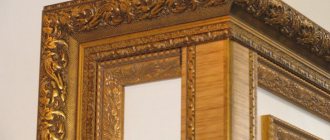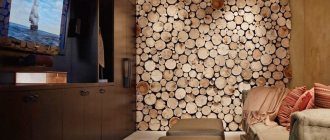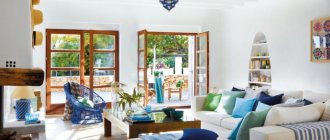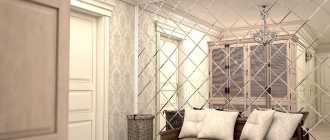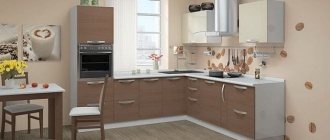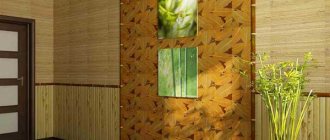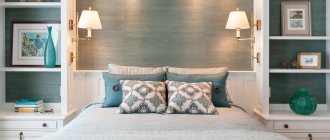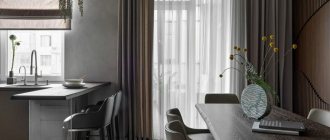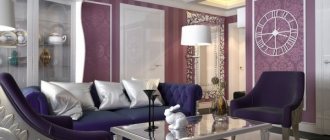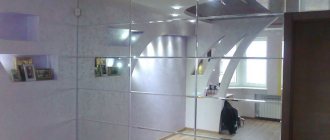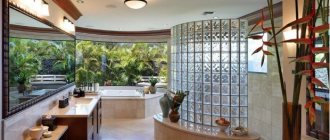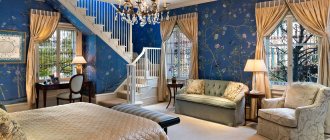Photo: nimvo.com
Today, manual labor has been replaced by automated technology, which produces hundreds of canvases in a short amount of time. In this regard, the cost of such work has also decreased, thanks to which people with different incomes can afford tapestries. However, handmade canvases, which can be ordered from specialized workshops from professional artists or purchased at a flea market, are still of greatest value.
Photo: ronniebrownlifesystems.com
The canvases most often depict landscapes, scenes from the Bible, pictures of hunting and ordinary walks. From the East, canvases came to us with images of samurai, flowers, trees, among which, of course, sakura occupied a special place.
Secrets from designers
more than one wall hanging cannot be used in one room;
This is an absolutely universal decoration tool.
each tapestry must be combined with other textiles;
tapestry paintings look better when they are large enough;
A huge tapestry is a bright, spectacular decoration for a minimalist living room.
Wall woven fabric adds even more coziness and warmth to the room
If you are using fabric as a bedspread or a set for a sofa, you should not immediately hang it on the wall or put a carpet on the floor; a painting would be more appropriate, but it is better to do without it at all.
Abstractly patterned trellis decor can be an interesting accent to a bright, open space in a modern or eclectic style.
If you decide on the classic use of a woven carpet and are going to place it at the head of the bed, or stretch it over the entire wall, you should think carefully about the image.
Decorate the wall behind the sofa with a large tapestry
What care does a modern tapestry need?
Medieval and modern tapestry are unpretentious, but this is not a reason to completely avoid maintaining their original appearance. The frequency of human intervention depends on the location of the product.
If the tapestry hangs in a public place, then it needs to be tidied up at least once every 7-10 days.
In the case when a carpet with a reproduction of a work of art is placed in the living room or bedroom, it must be kept clean once a year.
You don't need to go to the dry cleaner for this. Everything can be done with your own hands.
The procedure is as follows:
- Regularly wipe the surface with a special cloth;
- It is allowed to use a vacuum cleaner at minimum power, otherwise the wall paintings will quickly become unusable;
- Once every 10 years, the product can and should be sent to dry cleaning;
- It is forbidden to put tapestries in the washing machine;
- They should not be placed in direct sunlight.
Tapestries were first discovered in Ancient Egypt and then in the Persian Gulf countries. Masters of ancient times transferred existing landscapes to a wool base or created something new. As the clothing industry developed, the technological process became several times more efficient. Now the interior of any room will be decorated with work with the required dimensions and image.
Features of care
It is better not to clean material such as tapestry yourself. Small items can still be put into the machine for gentle treatment, but larger items are better dry cleaned.
When choosing, we take into account the color and stylistic design of the room
On any tapestry product there is a small instruction from the manufacturer on how to care for the product. These rules must be strictly followed in order for the item to last as long as possible.
Material characteristics
Tapestry fabrics are demanding on the quality of weft and warp threads. The weft should be soft and elastic, and the warp should be strong. The densest and thickest fabric options look the most luxurious due to the complex weave of the threads. Materials suitable for making fabric:
- natural wool (traditionally sheep's wool is used) is a durable fiber that is easy to dye;
- cotton and linen are natural plant threads that lighten the weight of the material;
- silk - fibers from the cocoons of the silkworm butterfly, the thread sets off wool and cotton, giving the canvas elegance;
- synthetic fibers;
- gold and silver threads, or lurex (metalized decorative threads).
Advantages of the fabric:
- wear resistance, dimensional stability and high density;
- ease of care;
- variety of textures, colors, ornaments, subjects;
- wide application;
- color fastness;
- antistatic properties - the fabric does not collect dust.
Flaws:
- heaviness and rigidity, which does not allow using tapestries to create clothing;
- home washing is contraindicated;
- It is also undesirable to iron tapestries - the fibers can form creases and bend.
Despite its shortcomings, tapestry is a sought-after furniture fabric. They produce fabric with a classic design - plant and floral patterns, oriental (oriental) patterns, as well as modern designs - cards, geometric images.
What it is?
A tapestry, or tapestry, is the result of one of the types of applied art. The finished product has both utilitarian and decorative properties. In modern design, a tapestry is treated as a work of art, a painting. No brushes or paints are used to create the canvas; the material is purely woven.
Thanks to the various interweavings of colored threads, a unique work is created, which is made on a specific theme, for example, a love story or one of the moments of a summer hunt, or it can also have an abstract meaning.
Types of wallpaper
Each species has its own characteristic features.
Paper
Paper wallpaper has a number of advantages over other types. The canvas material is environmentally friendly with obvious breathability properties, which in turn has a good effect on the microclimate of the room.
Non-woven
Non-woven wallpaper is characterized by wear resistance and durability. The fabric contains two layers: the first is non-woven, and the second can be paper, textile or vinyl. It is the non-woven layer that is responsible for the strength of the coating, and the subsequent layer for aesthetics!
The photo shows a bedroom with wallpaper in a small floral pattern.
Vinyl
Vinyl wallpaper, like non-woven wallpaper, consists of two layers - the top is vinyl (or polyvinyl chloride), and the bottom (adjacent to the wall) is non-woven or paper. Due to the thickness of the canvas, the illusion of volume and depth is created in the room. Taking advantage of this property, manufacturers combine the texture with various textures like wood, fabric, stone, rattan or decorative plaster, which makes the surface no worse than natural materials.
Vinyl fabric is durable, resistant to moisture and mechanical damage. The coating is suitable for use in rooms where frequent wet cleaning is required.
Textile
Textile wallpaper in the English style comes from the interiors of past centuries. However, even today, they continue to be in demand, because... consist of environmentally friendly materials - linen, silk, viscose, cotton or felt. This type consists of two layers - the first (closer to the wall) is based on paper or non-woven fabric, and the second is decorative, determining the aesthetics of the space as a whole.
Features of tapestry wallpaper
General information
Tapestry wallpaper is an elite type of textile wallpaper. Moreover, many of them are made according to the author’s sketches in a single copy. When making this material, linen or silk threads are glued to the base.
Most often, this coating is produced on the basis of non-woven fabric - a non-woven fabric made of cellulose fibers. Moreover, manufacturers of these materials do not use non-woven fabrics with the addition of polyester. Accordingly, the basis of this finishing material is completely natural.
The design is applied to the surface by hot stamping, resulting in a matte texture that is, however, quite contrasting and bright. When making tapestry wallpaper, designs are used that contain many small details drawn with a clear outline.
Example of a tapestry pattern
Most often, these are plant drawings, as well as images of natural elements, monograms, etc. Often, leading companies produce collections of so-called paired wallpapers. They contain plain canvases and a tapestry-like covering with a pattern.
This allows you to combine the coating with the background intended by the manufacturer. In this case, you do not have to independently select suitable canvases for the “tapestry”.
The most famous countries producing such coating are:
However, recently this material has also begun to be produced by manufacturers from other countries. This is due to the fact that the demand for it is consistently high.
Moreover, the popularity of the coating is associated not only with the atmosphere of luxury and grace that it can create in a room, but also with the thickness of the canvas, as well as its durability. Thanks to this, the material can well mask various flaws on the surface of the wall. As a result, gluing in some cases can be done without any preliminary preparation at all.
Advice! A tapestry cover can be used in a children's room. There are special pastel-colored canvases with children's themed drawings.
In addition, excellent permeability allows you to protect walls from dampness. If you are finishing an apartment in a multi-storey building, then such a point as the soundproofing properties of the material is also important.
Provence
Provence is provincial France, both luxurious and modest. You can safely choose bright colors to decorate your home, but in a Provence interior you should limit yourself to one or two accents. New Year's Provence style does not at all look like a pile of bright, expensive decor. Rather, it is attention to detail.
Aged furniture
Original handmade toys
The main palette of Provence is pastel. Most decor should be white, cream, gray or wood tones. Elements of “wornness” will bring a special charm to the interior, for example, furniture with slightly worn paint or decor made from untreated fir branches.
The secret of the popularity of tapestries
In the 21st century, almost everyone has the opportunity to decorate their own houses and apartments with tapestries if they agree to shell out a fairly significant sum of money. The reason for the high cost is the complex technique for creating such works. Arguments from the spiritual level and from the point of view of practicality allow you not to regret the expenses. The reason that inspires the use of tapestries in interiors of different styles is the creation of a mysterious atmosphere in the room and the opportunity to deeply feel the spirit of another country or time.
Main types of weave
Most often, tapestries are created using a loom. The essence of hand weaving is that the threads are intertwined. There are several different techniques, and depending on which one you choose, you can get different results. By the way, it is quite possible to create machines for creating tapestries with your own hands if you have experience working with wood.
Before you start weaving a tapestry, you need to select a suitable pattern and transfer it to a workpiece consisting of threads stretched on a loom. When such a unique sketch is ready, you can move on to translating it into color.
Slanted lines
As a rule, several types of different weaves are combined in one tapestry. This allows you to obtain the desired images and combine flat parts with embossed ones. Slanted lines are where threads of two colors meet in one place.
This type of weaving is used where you need to give the image a roundness or make its shape curved.
Circular technique
The circular technique, according to the masters, is not so common. However, it is also interesting in terms of what the final result is. In this case, threads of different colors go in a circle, and the finished image seems like a work of art, painted with broad and confident brush strokes. It looks really impressive and beautiful.
Contour technique
As the name suggests, this technique is used to highlight the outline of an object. For this, as a rule, denser threads are used than in the warp. If you use this technique, the drawing will be clearer and more detailed.
Decorative plaits
Decorative flagella are what can give the finished work additional attractiveness. With the help of strands, the base of the thread is wrapped around in certain places. Most often, this technique is used for edging individual fragments or focusing attention on part of the tapestry.
Additional decor
In addition to the basic weaving, you also need to remember about additional decorative elements. Feathers, beads and other details are used to decorate the tapestry. Sometimes even grass stems and dried flowers are woven into the finished pattern. This makes the picture fuller and more prominent.
Manufacturing technique
Traditionally, tapestries are created by hand. The process is reminiscent of weaving lint-free carpets, but it is more labor-intensive and painstaking, since the threads are much thinner and the pattern is very detailed.
Initially, the main tool for creating a product was an ordinary frame onto which warp threads were stretched. To achieve the required tension, they used nails driven into the frame or evenly made special holes on the inside of the frame itself. A weft thread, wound on a spool or simply wound into a ball, is thrown between the warp threads, and after completing the row, it is nailed with fingers or using a special mallet.
The process using a machine is considered more technical. Its peculiarity is that the machine can be placed both horizontally and vertically.
The master works according to a sketch drawn on cardboard, and the size of the design and color completely coincides with the size and colors of the future trellis. But despite the fact that the weaver has to copy another work, he must have artistic inclinations, be able to preserve color rendition, understand the intricacies of light and shade, and imagine what the finished woven work will look like in order to select the right thread in a given row.
Large manufactories producing products on a global scale even set up art schools at their factories, which improved the quality of the finished product.
Since the process of creating this canvas is very labor-intensive and time-consuming, up to 5-6 people can work on one trellis. Thus, one work is divided into several parts, which are then stitched together with silk thread. This could be understood by looking at the reverse side: there were seams on it.
Thanks to a large number of techniques, it is possible to achieve a variety of effects when making trellises. If in the classic form the warp threads remain invisible, then in the modern version the craftsmen can deliberately leave them on the front side of the design. This technique is called rep, because the fabric takes on a certain ribbed relief, which translated into French sounds like “reps”.
The modern tapestry as a decorative element has undergone great changes over the past decades. This type of decoration of walls and various surfaces has become so popular in recent years that it simply had to become more accessible to the masses.
A fully woven product is an expensive pleasure; few can afford such a luxury. But the non-woven tapestry is very simple to make, and in appearance it is almost indistinguishable from the original.
Such a product is created using a special layout of the pattern with colored fibers or threads on the base. It is difficult to call the product a tapestry in the traditional sense of the word, because a “tapestry” is, first of all, a woven fabric. However, the laid out pattern has a woven texture and a very detailed and dynamic pattern.
Chinese masters have come up with another type of non-woven trellis. The panels are made without the use of knitting needles or hooks. All elements are made of cardboard, onto which yarn is subsequently wound. The master glues ready-made parts onto the fully wrapped base and frame, creating a composition.
History of the creation of tapestry paintings
Weaving tapestries originated a long time ago. This is evidenced by numerous excavations, chronicles and other sources. The princely mansions were richly decorated with such tapestries. They were not only an exquisite decoration for the home, but also served as objects for performing magical rituals. Centuries earlier, tapestries served as decoration for the homes of nobles and royalty. In our country, under the tsar, creating a tapestry panel was not an easy task. Only a skilled craftsman with a keen sense of the combination of color and design could create such works of art. A tapestry today will transform a room, an office with unattractive walls into a cozy and comfortable space. After all, every woven picture is a true work of art. A tapestry panel will make any room original.
Through such fabric paintings it is possible to highlight one or another piece of furniture. Lighting in the room creates a play of light and shadow on the canvas, making the atmosphere more comfortable.
Products
Curtains, bedspreads and covers for sofas, beds, and pillowcases are made from this material. You can find home decorations such as napkins, tablecloths, and panels. There is a separate direction in tapestry products - icons. They not only decorate the room, but also serve as a symbol of well-being and peace in the house.
Unusual headboard design
Tapestry and popular destinations
East. A soft woven carpet is considered the hallmark of any oriental interior; it is used everywhere - on the floor, on the walls, as a bedspread, even as a texture on sofa cushions. If there are oriental notes in your home - an abundance of dummy, hookahs, jugs or vases with sharp necks, canopies, a large amount of textiles, etc., the tapestry will fit perfectly into the overall picture. In addition, bright oriental patterns are now in trend; after all, if someone is fundamentally against carpets, it could be themed embroidery on sofa decks.
The oriental ornament of the tapestry fits organically into the solid interior of the house
The wall carpet will perfectly complement the patio interior, made in oriental style.
Scandinavians. Photos of Scandinavian interiors are replete with dense wall fabrics with beautiful embroidery; designers intended them to serve as accent spots. A large tapestry painting, which you can make yourself from any special kit, would serve as a bright detail like this; the technique for making it is quite simple, but it will take some time due to its large volume.
The main raw material is usually wool, sometimes cotton or linen
A tapestry with a characteristic pattern in a living room designed in a restrained Scandinavian style
Modernity. Tapestry fabrics and modernity find a compromise in bright abstract designs. They are not so often hung on walls, but tapestry throws on a sofa and armchair with colorful original embroidery or a woven carpet on the floor often serve as a highlight and decoration of rooms. Many stores today offer bedding sets for the bedroom, which include decorative tapestry pillowcases and a bedspread; you can buy them in the bedding department.
Even in the loft style there is a place for tapestry
Canvas with a geometric pattern in an eclectic bedroom
Classic. The use of tapestry in a classic interior echoes the design of castle bedrooms, where the main place for carpets with patterns or huge paintings was allocated at the head of a large bed. Many owners of modern apartments, inspired by palace decorations and falling in love with luxury, even stretch fabric depicting a famous plot instead of wallpaper onto a full wall in the bedroom.
The unsurpassed luxury of the classics is emphasized by the wall tapestry
Vintage. In this style, the “trick” of the year was the combination of a tapestry at the head of the bed and the same carpet on the floor in the room. At the same time, the walls should be in pastel colors and monochromatic, in order to emphasize the woven nuances and not give a feeling of excessive diversity; the floor should contrast with the dark.
Canvas with a “faded” effect creates a feeling of antiquity
Having introduced tapestries into fashion, designers immediately gave some useful tips that will prevent your carpets and bedspreads from being associated with ghosts from the past.
Rooms and drawings
- Mythical creatures. You need to be careful with them, since they seriously occupy the imagination and indirectly affect the psyche. Such drawings can be hung anywhere, but not in a place of relaxation - the bedroom.
- Architectural structures and heraldry. Suitable for any room, but will look good only in rooms with fairly high ceilings and additions such as oak furniture, massive doors, and antiques.
- Reproductions of famous painters. They look good in the living room; you can spend a long time in them thinking and traveling inside on long evenings by the fireplace, living through historical events.
Art lovers can find woven paintings by famous artists - in certain interiors it will look quite original
Landscapes. They calm you down and allow you to calm down and fall asleep faster, best used in the bedroom.
It looks especially good on a white painted wall and can easily replace wall painting or a fresco
Consider the size of the wall when buying a trellis - a large picture will look good in an open space and make it more cozy
Floristry and still lifes. They are appropriate in absolutely any room, since the themes are light and do not excite the imagination too much.
A good decor idea would be to hang these pieces of art on either side of the fireplace.
Abstractions - they look most appropriate as drawings of covers for sofas and armchairs, however, as wall decor they can bring originality and effectiveness to the interior.
Spectacular wall decoration for the corridor
A tapestry above the bed is a bright note in the bedroom of a chalet house
Flashy tapestries on the walls, echoing the bright accents in the room, look very stylish and harmonious
Tapestries can also have a modern design, for example, with abstract motifs
This year's tapestry products can in no way be considered an echo from the past; the designers endowed them with original moments and flavor. The tapestry today is a unique bridge, skillfully connecting together the masterpieces of masters of past centuries and the present.
More information on the topic: https://happymodern.ru
Popular images on tapestries and their relevance in design
Emotionally neutral tapestries are appropriate in any room
- Architectural structures, heraldic motifs. They look good in classic interiors, but will not overload them only with sufficiently high ceilings.
- Mythical creatures. Psychologists say that such images have an impact on the subconscious, so they have no place in the bedroom.
- Reproductions of famous artists. Quite appropriate in most modern interiors, they will look best in the living room.
- Landscapes. A good location is in the bedroom, as they are peaceful and relaxing.
- Still lifes and floral motifs. Lightweight, they do not cause overstimulation or unpleasant emotions, making them suitable for any room.
- Abstractions make any interior original and spectacular.
Abstract tapestries look fresh and bright
The revival of interest in tapestry is not surprising. Texture, color saturation, and the value of manual labor turn the tapestry into one of the most striking emotional accents of the interior.
What is a tapestry?
Tapestry - translated from French means a woven pattern of threads on a canvas. This is a noble material used for sewing outerwear (jackets, cardigans, suits) and home textiles. It is made by jacquard weaving of lint-free threads in different shades. Thanks to the two-layer or three-layer structure, the pattern on the canvas is on both sides. Tapestry can be combined with other fabrics, creating textile decorative elements for the interior of any room.
This material is produced in two ways: traditional (manually) and automated (using weaving machines). The cost of tapestry made in the traditional way is higher, so it is rarely used for sewing bedspreads, pillows and curtains. Like any fabric, tapestry has advantages and disadvantages.
Its main advantages include:
- Strength. This fabric is difficult to cut, even with the sharpest knives and scissors, and it is impossible to tear it with your hands.
- Resistant to dirt and mechanical damage.
- Durability. Curtains, blankets, pillows, furniture upholstery, tablecloths, linens and other textiles retain their original appearance, even after many years of active use.
- Presentable appearance. Tapestry products in the interior emphasize the good taste and status of the owner.
- Protection. Thick tapestry curtains practically do not let sun rays and cold air into the room, which provides reliable protection at any time of the year.
The disadvantage of the material is its heavy weight, so it is important to hang tapestry curtains on a durable cornice attached to the wall with anchors
Tapestries in various styles
Despite the fact that after the collapse of the USSR, one began to hear from everywhere “a carpet on a wall or on a bed is a relic of the past, this is a village,” many people are in no hurry to abandon this not only beautiful, but also a warm-preserving interior detail. And they are doing the right thing, not every carpet is an atavism that cannot fit into the general style; many of them are so original that they look harmonious in the most popular trends today. Tapestry fabric provides such a wide field for imagination that few would dare call skillful hand-woven work or embroidery an ordinary old carpet.
The attitude towards such a decorative element is ambiguous even among professional designers and decorators.
Decorative canvas with fish complements the interior of a modern living room
Bright, eye-catching canvas in a stylish living room
Bright Mexican motifs look impressive against the background of white walls
A tapestry on the wall completes the warm, cozy interior of a wooden house
Bed sheets
We spend 8 hours a day sleeping - over a lifetime, that adds up to 25 years - about a third of our lives, which is why the choice of bedding is so important. In addition, the bedding we use can change both our mood and our interior. Modern materials amaze with a riot of colors and the quality of textiles, so bed linen can also become the decor of a room.
Today, the variety of bed linen is very impressive; it is found in absolutely every color and taste. The aesthetics of bedding are also subject to fashion trends, just like clothing. Colors familiar to the older generation, such as “polka dots” or “calico printed flowers,” are gradually becoming a thing of the past. Every year, designers such as Armani, Sonia Raquel, Donna Karan come up with and implement more and more new ideas regarding bed linen.
If you sleep on a large bed, then beautiful bed linen can become an independent element of room decor or in combination with a bedspread. Choose the design and color you like and it will not only be pleasant to sleep on such linen, but also to look at it.
To the begining
Home decoration: tapestry panels
Any tapestry panel carries its own information in the image and, admiring the scenes, each person receives aesthetic pleasure and discovers something new.
If you need to decorate your kitchen with a tapestry, choose still lifes and images with flowers. To decorate the office, tapestries with images of a seascape or hunting are used, for example, “Corsica” on a lining. Production quality is guaranteed. The weave of the fabric threads is tight. Threads are used in different thicknesses. This creates image volume and clarity. Tapestry is simply indispensable for decorating an apartment, house or office. Also, such panels are considered a wonderful gift for almost any celebration. Giving tapestries to friends, relatives and bosses is a sign of taste and good manners.
A tapestry panel in the interior is an excellent option to decorate a wall in your home. Interesting decor will bring novelty and individuality to the interior of any apartment and beyond. All tapestry panels contain a special lining; it has a hole through which a cornice is inserted; through the cornice, the tapestry is hung on the wall. This hole, called a pocket, is usually located on top of the panel. There are tapestries that are equipped with a pocket at the bottom in order to weigh down the picture to prevent bunching and bending of corners. Thanks to the presence of two pockets, placing the panel on the wall is easier and faster.
The buyer can purchase a panel without a frame or in a baguette frame, as well as in a wooden frame. The design emphasizes the originality of the plot on the canvas, and it should also be combined with other decorative details in the room. In order to decorate small niches, narrow tapestry panels fit perfectly into the interior. Large tapestries look good on large walls. Above the sleeping area of the room there are horizontal tapestry paintings.
History of appearance
There is an opinion that tapestries are a relic of the past, and that a carpet on the wall is not just yesterday, but also a sign of bad taste. However, the history of panels goes back to ancient times and can easily compete with paintings and other accessories.
A tapestry is a lint-free carpet woven with cross-weave threads. Due to the presence of a plot and ornamental composition, it belongs to the decorative and applied arts. The woven carpet received the French name “tapestry” after the establishment of the royal Gobelin manufactory in Paris in the 17th century. However, the first panels appeared during the times of Ancient Egypt and Ancient Greece.
Ideal for classic style
Hundreds of years ago, tapestry making was done by hand, requiring enormous amounts of time, material and labor. Therefore, only wealthy people could afford such luxury. With the advent of automated production, the process has been significantly simplified, making the treasured panel more accessible.
However, handmade work has not lost its value, and it is no coincidence that collectors pass on tapestries by inheritance, and handmade products become the decoration of palaces in the East.
Story tapestry – where to hang it?
Initially, tapestries served not only as wall decor, but also served as insulation. They can be safely called fabric carpets. Hand-woven tapestries are made from wool and silk threads using gold and silver dyes. In Europe, the main motifs of fabric carpets were pastorals - scenes from life. Such tapestries often depicted landscapes with hunters, shepherds or walking girls. It is precisely these kind of narrative textile products that we most often associate with the very concept of tapestry.
Another direction in creating textile paintings is associated with the East. From there came to us exquisite landscapes, images of flowers and plants, including sakura, birds and animals, beloved by many oriental masters, and portraits. In such tapestries, gold threads and silk raw materials, dyed with natural dyes, were especially often used.
In the East, textile paintings were given special significance. Fabric scrolls served not only as decor for decorating a home; craftsmen believed that they were able to drive away evil spirits from the home or attract positive energy, luck and wealth.
Nowadays, tapestries are not only textile wall carpets, but also bedspreads, covers for decorative pillows, original panels and tablecloths, draperies for window and doorways and much more.
Narrative tapestries, reminiscent of those hand-woven by our ancestors, would look great in a classic living room. Golden threads in textile carpets combine perfectly with the shine of luxurious chandeliers and sconces, echoing the gilded decorative elements of mirror and picture frames.
If your living or dining room has a fireplace, you can use the space above it to place a story tapestry. Obviously, the hearth most often acts as the center of attraction in the room, and with the support of a fabric pattern, the entire ensemble will look especially impressive.
If you are still hesitant to hang a story tapestry in the rooms where you spend a lot of time, in the bedroom or living room, try using wall decor in additional rooms. A tapestry with a landscape will look great in a spacious hall or hallway. Some private homes and hallways have enough free space to accommodate wall decor in the form of fabric rugs. The main thing is that there is enough free space to view the entire textile picture.
Decorative elements in vintage style
Decorating a room in vintage style will be incomplete without the use of decorative elements. They must be carefully selected to prevent the space from feeling like an exhibition or simply cluttered. The most common items that match the vintage style are: antique watches; carved boxes; china; original candlesticks; embroidered tablecloths; knitted napkins; delicate curtains with cutwork embroidery; rag dolls; copper figurines; framed black and white photographs.
A mandatory attribute of vintage style is a bouquet of dried flowers in winter and fresh flowers in summer. The most popular materials are copper, ceramics and wood.
Interior styles
It can be used as small inserts in any interior, but the tapestry has gained the most popularity in three styles:
- Oriental. An irreplaceable detail of any room with oriental design. Inserts with floral patterns help achieve the effect of peace and concentration.
- Art Deco. Only abstract patterns and geometric shapes appear on the canvases; foliage and floral compositions are not suitable. The fabric used is grey, white and black.
- Baroque.
Place in the interior
Finally, it’s worth mentioning how to use tapestries to decorate any room. After all, the overall impression will depend on how appropriate it will be in the interior and how well the picture will fit into it. Even the most expensive canvas will seem superfluous and out of place if it is chosen incorrectly. This means your money will be wasted.
Use instead of wallpaper
Beautiful and large tapestries can easily be used instead of wallpaper if you have a small room. Most often, one of the walls is decorated in this way. This is more profitable and much more interesting than simply pasting wallpaper around the entire perimeter of the room. Thick tapestry fabrics are a great way to insulate a room and create excellent sound insulation.
In the bedroom
A beautiful tapestry can be easily hung in any of the bedrooms. This could be a children's room or a room where adults relax. Here, by definition, everything depends on what picture is printed on the fabric. For example, in a nursery it is most logical to use cute cartoon or fairy-tale images, and in a couple’s bedroom - landscapes or romantic pictures.
In the office or library
Another room with tapestries that deserves attention is a home office or library. A beautiful old vintage tapestry is a luxurious addition to any office. Discreet pastel colors, antique patterns and other beautiful details would be appropriate here.
In a country house
The use of tapestries in country houses or in the country deserves special attention. It is in such conditions that they look most organic. Antique or antique-style canvases with images of nobility, royal hunting or architectural works of art would be appropriate here. With a beautiful and correctly selected tapestry, even the simplest cottage will become much better and more comfortable. And of course, don’t forget how well tapestries insulate walls. This means that with a luxurious canvas it will be much easier for you to survive the cold winter.
Choose a tapestry that matches all the features of the interior in color and style. The product should go well with the color of other fabric products, for example, with curtains, blankets, rugs, pillows or other textiles. This way you can create a harmonious and thoughtful interior that will look much more original than any simple room in a standard design solution.
If previously tapestries were used to decorate the houses of the nobility or other luxurious premises, now almost anyone can easily decorate their premises with such a product. Choose a modern tapestry that suits your style and mood or buy a luxurious antique product, and your interior will “come to life” and sparkle with new colors.
You will learn more about how to decorate the interior with a tapestry in the following video.
Options for using tapestry in the interior of a modern home
Fans of fashionable novelties are wary of tapestry products, making a huge mistake.
A modern tapestry in the interior of an apartment or house looks relevant and stylish, fitting well into almost any design style. The tapestry is based on a special interweaving of multi-colored threads, which produces spectacular patterns and durable products that retain their beauty for many years. Learn how to use tapestry decor in design and how to properly dispose of quality products.
- What is a tapestry and how to choose it correctly
- Which tapestry products are suitable for the interior
- Tapestry curtains - maximum privacy and comfort
- Tapestry pillows are the best choice for practical
- Bedspreads and covers for furniture
- Paintings and panels are an alternative to carpets
- In what design style is a tapestry appropriate?
- Country is the best choice
- Tapestry notes in classic style
- Art Nouveau in a tapestry frame
- Tapestries in modern design trends
- How to quickly update your interior
What is a tapestry and how to choose it correctly
of the Tapestry Store understand what a tapestry is and how to choose the right durable products from it . On the website of this store there are a lot of original pillows with realistic images of animals, beautiful patterns and designs. For interior decor there are bedspreads, paintings, panels, napkins, tablecloths and even fashionable bags.
Tell me, what kind of fabric is this, how is it produced?
The first tapestries appeared in the 17th century in France; the fabric was named after the Gobelin brothers, who owned a weaving factory producing this amazing fabric. Later, Louis 14 bought the company, and tapestry carpets became the hallmark of France.
In professional terms, a tapestry is produced by weaving the weft and warp (longitudinal and transverse threads). Technically, the process is simple, but the complexity and value of the canvases are the luxurious ornaments and scenes that are created on the machine, and not by printing on fabric. The result is a very beautiful and realistic image, similar to painting.
Previously, tapestry products were very expensive, since weavers worked by hand, spending a lot of time on production. In a year, a master can weave only one and a half square meters of fabric by hand! Modern machines work quickly, and the quality of the material has even improved. Look at the cat pillows we sell, they will leave no one indifferent!
How to choose the right tapestry for your interior so as not to fall for the trick of a dishonest manufacturer?
A tapestry from a well-known manufacturer is always of good quality, since it is difficult to “taint” it during its production. Pay attention to the quality of the image, the thickness of the product, inspect the purchase from the front and back sides. Look at the composition of the canvas. Natural fabrics are made from wool, silk, and linen. However, you should not be afraid of synthetics; it simplifies care and makes the products more practical.
If you live in Moscow, come to our store at the address : Michurensky Prospekt, Olympic Village, building 4.building 3. We’ll show you, tell you, and help you choose.
When choosing products, consider the color and stylistic combination with existing interior items and decor. When buying a panel, think about where it will hang. Tapestry paintings look beautiful if they are located on a free wall and adjacent to other wall decorations.
How to care for a tapestry so that it lasts a long time?
It is best to take your items to the dry cleaner. Small items can be washed at home using the most gentle cycles. Each product should have a care instructions from the manufacturer, and you need to follow it when caring for it.
Which tapestry products are suitable for the interior
Tapestry is used to make curtains, pillowcases, bedspreads and sofas. To decorate the interior, they create paintings, panels, napkins, and tablecloths. A separate direction is icons, which not only decorate the home, but also create an atmosphere of peace and well-being in it.
Tapestry curtains - maximum privacy and comfort
Luxurious tapestry curtains in the interior of a bedroom or living room have no equal in the quality of protection from prying eyes. Thick fabric leaves no chance for curious neighbors, even with the lights on in the room. Even silhouettes are not visible through such curtains, so you can feel confident and protected at home.
Tapestry curtains do not let the sun's rays into the room . Thanks to this, the room is not so hot in summer, and furniture and wallpaper do not fade or deteriorate from exposure to ultraviolet radiation. The tapestry itself retains its original appearance for a long time, unless, of course, the manufacturer skimped on quality.
The dense material is suitable for creating simple curtains in one layer and for decorating windows with tiered and draped curtains. The fabrics go well with any tulle - from simple to luxurious. The main thing is not to forget about the weight of the material and ensure reliable fastening.
Tapestry pillows are the best choice for practical
Tapestry pillows are very practical, as the fabric is wear-resistant, does not electrify and is pleasant to the touch. These pillows will decorate your living room, bedroom or children's room if you choose a suitable pattern or a funny design.
It is convenient if the pillowcases are removable , the tapestry can be vacuumed and cleaned, and the old pillow can be easily replaced with a new one or washed separately. Tapestry pillowcases last for many years. They can be used not only in an apartment, but also in a country house, in a gazebo, or on a loggia.
Bedspreads and covers for furniture
A good-quality tapestry blanket for a bed or sofa will decorate the interior and protect the furniture from dirt and damage. It’s easier to dry clean a bedspread than to clean a sofa. Tapestry bedspreads do not become pilled and are resistant to tugging; they are very practical and durable.
You can put a bedspread with a large pattern on the bed, for example, a huge sleeping animal or a flower meadow. For a sofa that is used for its intended purpose, it is better to buy a tapestry bedspread with a fine pattern. In such a picture, traces of time from intensive use will not be visible.
For children, there are separate lines with funny children's drawings - plots from your favorite fairy tales, cartoon characters, heroes from famous games. Such things transform the interior of a children's room.
Paintings and panels are an alternative to carpets
Previously, carpets were woven from tapestry to decorate and insulate walls. Today, no one hangs large carpets on the walls; they have been replaced by paintings and panels. This decor looks very interesting. Modern weaving looms can create realistic images that look no worse than the canvases of famous artists.
You can depict anything in a tapestry painting, so it will not be difficult to find such decor to suit any interior style - from luxurious classics to loud avant-garde and meager minimalism. The style is dictated by the subject and the frame . Large-sized paintings are an excellent choice for a spacious living room, and small ones look good above chests of drawers, fireplaces, and sofas.
Tapestry panels are ideal for children's rooms, bedrooms, living rooms, hallways. The panel can be supplemented with hooks or pockets, turning it into a storage place for small items. This option is ideal for the hallway.
In what design style is a tapestry appropriate?
Handcrafted rugs adorned walls and floors hundreds of years ago. Modern tapestry is more delicate, and the patterns are clearer and more sophisticated. Thanks to new technologies, it has become possible to create complex patterns with smooth transitions. Such products are appropriate in any interior.
Country is the best choice
If you like country music, then feel free to choose tapestries to decorate your bedroom and living room. For such an interior, products with traditional patterns and ornaments, a little rough, emphasizing the simple-haired rustic style, are more suitable.
In country style, floor mats, tablecloths, napkins, and curtains are appropriate. Complete the sofa with bright pillows or a blanket. Instead of a wall hanging, hang a picture or panel. If you wish, decorate a corner with an icon. Don't forget about the little things - hang a tapestry bag in the hallway on a simple hook or nail.
In a rustic style, bright colors are appropriate, and colorful designs are acceptable. However, we must not forget about a sense of proportion and color combinations; too much will ruin all your efforts.
Tapestry notes in classic style
In a classic style, everything should be done in soothing colors ; cheap trinkets and bad taste are not allowed here. Choose good quality decorative tapestry pillows for the sofa, good curtains in pastel or brown tones, combined with natural wood furniture and parquet.
Tapestry paintings will complement the interior and make it more status. In a large living room you can hang two paintings, maintaining the symmetry inherent in the classical style. One picture will look beautiful above the mantelpiece or above the sofa. Do not forget that the frames should be expensive, made of precious wood, and if metal, then with gilding or silver.
In a classic-style bedroom, place a tapestry bedspread on the bed, choose suitable pillowcases for pillows, and close the windows with heavy curtains. Above the bed, find a place for a painting or panel. By covering the walls, you will provide not only comfort, but also additional thermal insulation if the wall is external - this is precisely the purpose for which carpets were previously hung on walls.
Art Nouveau in a tapestry frame
Modern is the style of those who like classics with a twist and modern notes. A tapestry in the interior of a living room or bedroom in Art Nouveau style is more than appropriate. Do not forget to adhere to the main trends of Art Nouveau - choose a tapestry with plant and floral patterns in natural shades for decoration. If the room is small, paintings with landscapes stretching into the distance and endless seas will help out.
Curtains in the living room or bedroom should be floor-length; tiers and expensive tiebacks are welcome. Match the color of the curtains with a tapestry bedspread for the sofa and chair covers. Don't forget about the little things - tapestry boxes, album covers, lampshades, all this will make the atmosphere warmer and homelier.
Tapestries in modern design trends
A modern tapestry does not violate the style of newfangled design trends. Bright avant-garde drawings, fashionable black and white combinations in the style of photography, pillows with images of cartoon characters, panels and paintings with realistic three-dimensional subjects - all this is acceptable in a modern interior.
The main thing is to maintain the style and do not mix styles, unless, of course, it is eclecticism, the main advantage of which is the ability to mix and match similar design trends.
Instead of classic sofa pillows, choose comfortable bolsters. Give preference to fashionable modular paintings or panels with futuristic scenes.
The tapestry goes well with concrete and brickwork, which means it will organically fit into the loft and industrial style.
How to quickly update your interior
When it is not possible to buy new furniture or make repairs, a tapestry will help out - with its help it will not be difficult to update the interior, changing it beyond recognition.
- A new tapestry blanket for the sofa will not leave a trace of boring old furniture, it will hide scuffs of the upholstery, stains from baby food and puffs left by the cat.
- Tapestry pillowcases are a great alternative to buying new pillows. By the way, such pillowcases are very convenient for storing spare bed linen , blankets, and winter clothes. No one will guess that these are not pillows, but full-fledged storage spaces. Beauty and significant space saving in the closet.
- Lots of tapestry pillows of different sizes will transform the simplest and most boring sofa. If your old sofa cushions have lost their shape, throw them away, replace them with new ones and enjoy the new look and comfort.
- Tapestry paintings will add luxury to even the simplest wallpaper. A correctly selected image will correct the shape of the room - making it wider, bigger and even taller.
- Woven napkins will decorate old furniture and hide scratches on a chest of drawers or bedside table.
- A new tablecloth will instantly transform an old table that is about to leave the apartment.
Try using a tapestry in the interior of your living room or bedroom and see its modernity, beauty and practicality from your own experience! The products shown in the photo can be purchased at the gobelenmagazin.rf store .
If you like to create coziness with your own hands, take a look at our Home section, it contains tips for those who want to live in a beautiful environment without unnecessary expenses.
Vintage style furniture
Regardless of the basic decoration, style cannot be created without furniture. To match the vintage trend, it must be antique or antique-style. It’s not bad if there are traces of abrasions or small cracks indicating the past. But at the same time, the furniture must remain durable and aesthetically pleasing.
The most prominent representatives of vintage style furniture are:
- carved wooden dressing table;
- "grandmother's" chest;
- "country" buffet;
- sideboard with an exquisite pattern;
- rare chest of drawers;
- rocking chair.
Another important point is that all pieces of furniture must, to a certain extent, be in harmony with each other and belong to the same era, but museum-like appearance is unacceptable.
How tapestry paintings are made: features of the technique
A product created only using natural materials is distinguished by its durability. Real tapestry paintings have a wool, linen or silk base. In cheaper products, the emphasis is on artificial fabrics. At the same time, the guaranteed service life of such a tapestry will not exceed 10-12 years. Before purchasing and hanging an embroidered picture on the wall, you need to study in detail the composition of the fabric and the type of dye used.
Traditional production technology uses only natural materials. On the one hand, they cost more, but, on the other hand, the flowers and all the details look as realistic as possible. This pattern will not fade over time.
It would be a good idea to pay attention to a number of other significant nuances:
- Designers do not recommend using tapestries separately from other stylistic details. A harmonious atmosphere in the interior is created with the help of smooth transitions. Matching furniture upholstery, wall and curtain designs will help make the decor more complete.
- The type of fabric is selected taking into account the planned dimensions of the tapestry.
- The quality and durability of the applied pattern depends on the correct preparation of the layout. There are no restrictions regarding what images can be transferred to the panel. The main thing is that the sketches take into account the degree of density of the fabric. The more saturated the color is needed, the denser the material should be.
Tapestries or, as this fabric is also called, tapestries, has been known to mankind for thousands of years. At first, beautiful images on fabric were created by hand over several months.
Over time, modern technology came to the aid of the craftswomen, speeding up the process 10 times. Now everyone has the opportunity to acquire a fabric painting for the living room or bedroom.
Before making a purchase, you need to make sure that natural materials were used to produce the tapestry.
Selection of materials
Creating tapestries is not limited to the choice of any one material. The first place in terms of demand belongs to jacquard. It's all about the density of its texture, which makes it easier to apply the pattern of interest. There are quite a lot of works on sale made using thin cotton fabric, woolen or terry options.
From the Middle Ages to the present
The history of tapestries goes back to the distant past: this weaving art was known back in Ancient Egypt. But the prototypes of modern tapestries are considered to be the works of medieval German monks. The woven carpets that hung on the cold walls of the monasteries were not used for decoration, but served a completely utilitarian purpose, providing thermal insulation for the premises.
By the end of the Middle Ages, this art began to flourish in Western Europe, and workshops began to appear that produced tapestries for wealthy citizens. Making carpets at that time was a very expensive and painstaking task: one tapestry could take several years of work from an entire village. Only members of royal families and representatives of the highest nobility could afford to purchase such products.
The most common images of that time were biblical motifs, as well as narrative paintings depicting hunting, life at court, and military campaigns. When fresco painting spread in the southern part of Europe, in colder countries they were replaced by tapestries, which borrowed both subjects and color techniques from frescoes.
Medieval tapestries told about people's lives
Antique tapestries from Reims Cathedral in France
Paris became the center of tapestry production in the Middle Ages, where these paintings were extremely popular. Those who could afford it ordered a whole series of paintings. They were used to decorate houses and temples, they were used to create mobile corridors on the streets for festive processions, and they were used to decorate stands at knightly tournaments. Sketches for tapestries were created by Raphael, Rubens and other famous artists of the past. Today, most of the ancient tapestries are on display in major museums in Europe.
In parallel, the development of weaving was going on in the east. In Mongolia, Ukraine, Moldova and Russia, lint-free carpets were also woven, which were used both in home decoration and in ritual ceremonies. They were very different from European tapestries: they were mainly decorated with floral and geometric designs, but the manufacturing technology was very similar.
The fashion for tapestries came to Russia during the era of Peter I. At his instigation, weaving masters were invited to St. Petersburg and the first tapestry workshop was opened. The first Russian tapestries depicted scenes from paintings by French and domestic artists.
With the development of factory production, the artistic level of tapestries fell sharply. They ceased to be a luxury, became more accessible to the ordinary population, and images were increasingly copied from popular artistic paintings.
Ethnic ornaments are typical for tapestries of Central Asia and the Middle East
The second wave of popularity of tapestries in the world occurred in the 20th century. Picasso, Matisse, Dali, Kandinsky are just a few artists whose sketches were used as the basis for new products. It was then that tapestries turned from an applied craft into a component of high art, which they remain to this day.
Tapestries make a room more interesting and sophisticated
Varieties
Nowadays, not only antique works of art, but also stylized carpets are called tapestries. Let's look at the main differences between classic tapestries and models created using a similar technique.
Smooth
Wall hangings are a trend that is long gone. But stylish tapestries, on the contrary, are gaining popularity. The simplest option is smooth models without a relief pattern and additional voluminous decor. These tapestry carpets are created using traditional techniques. They can be easily hung on the wall or placed on the floor depending on your aesthetic preferences.
Textured
A slightly more complex version of tapestries is textured products. In this case, the product is created using traditional techniques, and only then decorated with convex stitches. This allows you to create a relief canvas that is attractive not only because of its appearance, but also to the touch.
Multi-level
This combined model is also very interesting in appearance. Several techniques are combined here. For example, a crocheted rug can be complemented with elegant embroidery or fringe along the edges.
Non-woven
This is one of the most interesting options for creating tapestries. Such paintings are made from fabric, but using different techniques. Most often, such tapestries are created using embroidery, knitting or appliqué.
Now there are many interesting options for tapestries, both large and small. Therefore, you can easily choose a beautiful decorative attribute, regardless of whether you need a vintage and truly antique product or just a stylish decorative element without any history that it would store.
